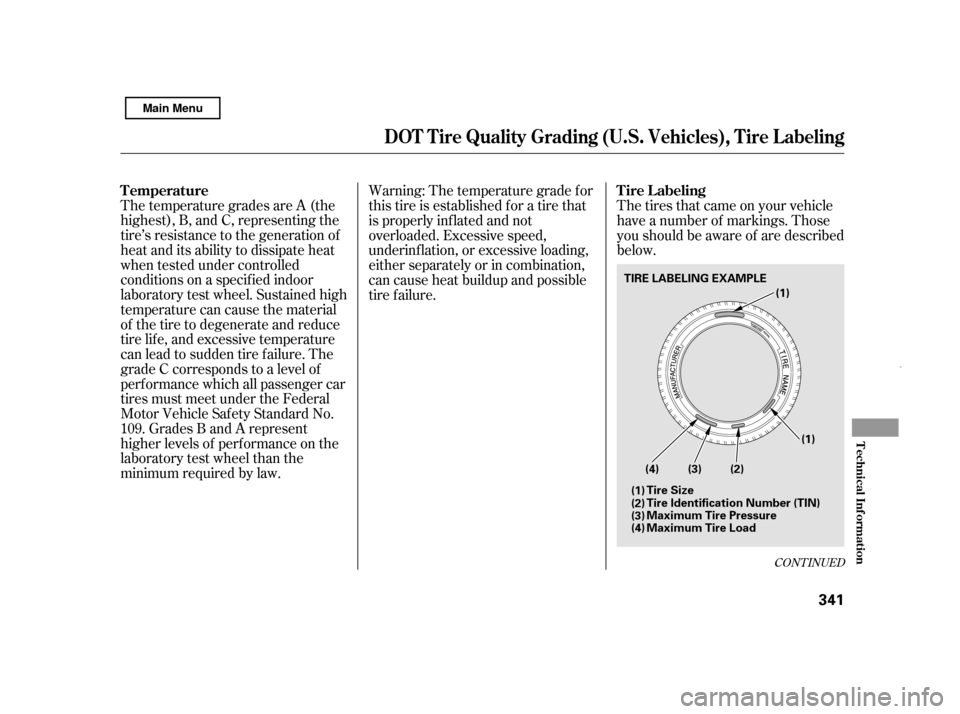Page 345 of 369

The temperature grades are A (the
highest), B, and C, representing the
tire’s resistance to the generation of
heat and its ability to dissipate heat
when tested under controlled
conditions on a specif ied indoor
laboratory test wheel. Sustained high
temperature can cause the material
of the tire to degenerate and reduce
tire life, and excessive temperature
can lead to sudden tire f ailure. The
grade C corresponds to a level of
perf ormance which all passenger car
tires must meet under the Federal
Motor Vehicle Saf ety Standard No.
109. Grades B and A represent
higher levels of perf ormance on the
laboratory test wheel than the
minimum required by law.Warning: The temperature grade f or
this tire is established f or a tire that
is properly inf lated and not
overloaded. Excessive speed,
underinf lation, or excessive loading,
either separately or in combination,
can cause heat buildup and possible
tire f ailure.
The tires that came on your vehicle
have a number of markings. Those
you should be aware of are described
below.
CONT INUED
Temperature
Tire L abeling
DOT Tire Qualit y Grading (U.S. Vehicles), Tire L abeling
T echnical Inf ormat ion
341
(4) (3) (2)
(1)
(1)
(1)
(2)
(3)
(4)
TIRE LABELING EXAMPLE
Tire Size
Maximum Tire Pressure
Maximum Tire Load
Tire Identification Number (TIN)
Main Menu
Page 346 of 369

�µ
�µ �µ
�µ �µ �µ �µ
�µ �µ �µ �µ �µ �µ �µ
Tire type code.
Date of manufacture.
Whenever tires are replaced, they
should be replaced with tires of the
same size. The f ollowing is an
exampleof tiresizewithan
explanation of what each component
means.
Vehicletype(Pindicates
passenger vehicle).
Tire width in millimeters.
Aspect ratio (the tire’s section
height as a percentage of its
width).
Tire construction code (R
indicates radial).
Rim diameter in inches. Load index (a numerical code
associated with the maximum
load the tire can carry).
Speed symbol (an
alphabetical code indicating
the maximum speed rating).
The tire identif ication number (TIN)
is a group of numbers and letters
that look like the f ollowing example.
TIN is located on the sidewall of the
tire.
This indicates that the tire
meets all requirements of
the U.S. Department of
Transportation.
Manuf acturer’s
identification mark. Year
Week
Maximum Inf lation Pressure The
maximum tire air pressure that the
tire can hold.
Load Rating Means the maximum
load that a tire is rated to carry f or a
given inf lation pressure.
Cold Tire Pressure The tire air
pressure when the vehicle has been
parked f or at least three hours or
drivenlessthan1mile(1.6km).
P R DOT B97RFW6X 2202
S
19565 15 89
Tire Labeling
Tire Size
T ire Ident if icat ion Number (T IN)
Glossary of T ire T erminology
342 DOT B97R FW6X 2202
P195/65R15 89S
Main Menu
Page 347 of 369

�µ
�µ
�µ
�µ
�µ As an added safety feature, your
vehicle has been equipped with a tire
pressure monitoring system (TPMS)
that illuminates a low tire pressure
telltale
when one or more of your tires is
signif icantly under-inf lated.
Accordingly, when the low tire
pressure telltale illuminates, you
should stop and check your tires as
soon as possible, and inf late them to
the proper pressure.
(If your vehicle has tires of a
dif f erent size than the size indicated
on the vehicle placard or tire
inf lation pressure label, you should
determine the proper tire inf lation
pressure f or those tires.)
Each tire, including the spare (if
provided), should be checked
monthly when cold and inf lated to
the inf lation pressure recommended
by the vehicle manuf acturer on the
vehicle placard or tire inf lation
pressure label.
Maximum Load Rating Means the
load rating for a tire at the maximum
permissible inf lation pressure f or
that tire.
Recommended Inf lation Pressure
The cold tire inf lation pressure
recommended by the manuf acturer.
Treadwear Indicators (TWI)
Means the projections within the
principal grooves designed to give a
visual indication of the degrees of
wear of the tread.
CONT INUED
U.S. models only
Tire Labeling, Tire Pressure Monitoring System (TPMS) Required Fe
deral Explanation
Tire Pressure Monitoring System
(T PMS) Required Federal
Explanation
T echnical Inf ormat ion
343
Main Menu